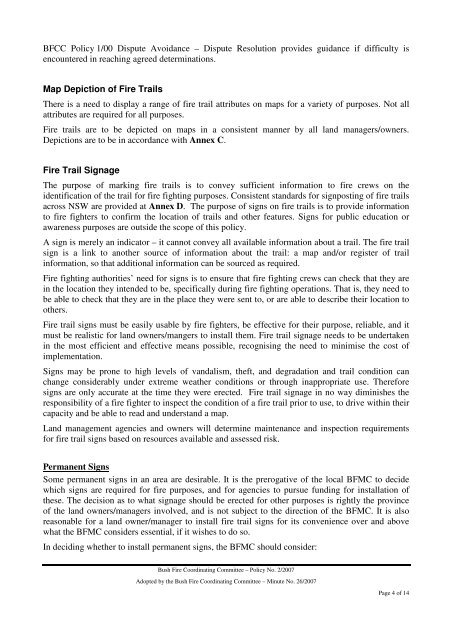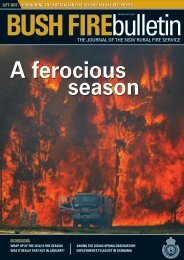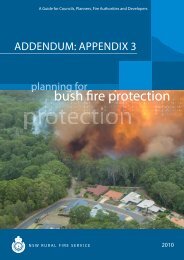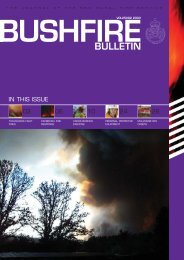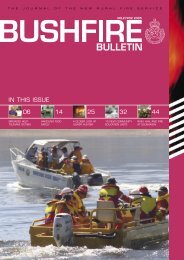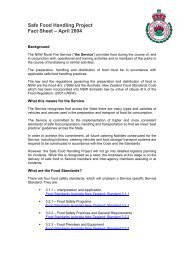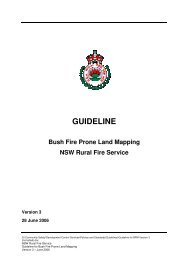POLICY NO. 2/2007 FIRE TRAILS - NSW Rural Fire Service
POLICY NO. 2/2007 FIRE TRAILS - NSW Rural Fire Service
POLICY NO. 2/2007 FIRE TRAILS - NSW Rural Fire Service
You also want an ePaper? Increase the reach of your titles
YUMPU automatically turns print PDFs into web optimized ePapers that Google loves.
BFCC Policy 1/00 Dispute Avoidance – Dispute Resolution provides guidance if difficulty is<br />
encountered in reaching agreed determinations.<br />
Map Depiction of <strong>Fire</strong> Trails<br />
There is a need to display a range of fire trail attributes on maps for a variety of purposes. Not all<br />
attributes are required for all purposes.<br />
<strong>Fire</strong> trails are to be depicted on maps in a consistent manner by all land managers/owners.<br />
Depictions are to be in accordance with Annex C.<br />
<strong>Fire</strong> Trail Signage<br />
The purpose of marking fire trails is to convey sufficient information to fire crews on the<br />
identification of the trail for fire fighting purposes. Consistent standards for signposting of fire trails<br />
across <strong>NSW</strong> are provided at Annex D. The purpose of signs on fire trails is to provide information<br />
to fire fighters to confirm the location of trails and other features. Signs for public education or<br />
awareness purposes are outside the scope of this policy.<br />
A sign is merely an indicator – it cannot convey all available information about a trail. The fire trail<br />
sign is a link to another source of information about the trail: a map and/or register of trail<br />
information, so that additional information can be sourced as required.<br />
<strong>Fire</strong> fighting authorities’ need for signs is to ensure that fire fighting crews can check that they are<br />
in the location they intended to be, specifically during fire fighting operations. That is, they need to<br />
be able to check that they are in the place they were sent to, or are able to describe their location to<br />
others.<br />
<strong>Fire</strong> trail signs must be easily usable by fire fighters, be effective for their purpose, reliable, and it<br />
must be realistic for land owners/mangers to install them. <strong>Fire</strong> trail signage needs to be undertaken<br />
in the most efficient and effective means possible, recognising the need to minimise the cost of<br />
implementation.<br />
Signs may be prone to high levels of vandalism, theft, and degradation and trail condition can<br />
change considerably under extreme weather conditions or through inappropriate use. Therefore<br />
signs are only accurate at the time they were erected. <strong>Fire</strong> trail signage in no way diminishes the<br />
responsibility of a fire fighter to inspect the condition of a fire trail prior to use, to drive within their<br />
capacity and be able to read and understand a map.<br />
Land management agencies and owners will determine maintenance and inspection requirements<br />
for fire trail signs based on resources available and assessed risk.<br />
Permanent Signs<br />
Some permanent signs in an area are desirable. It is the prerogative of the local BFMC to decide<br />
which signs are required for fire purposes, and for agencies to pursue funding for installation of<br />
these. The decision as to what signage should be erected for other purposes is rightly the province<br />
of the land owners/managers involved, and is not subject to the direction of the BFMC. It is also<br />
reasonable for a land owner/manager to install fire trail signs for its convenience over and above<br />
what the BFMC considers essential, if it wishes to do so.<br />
In deciding whether to install permanent signs, the BFMC should consider:<br />
Bush <strong>Fire</strong> Coordinating Committee – Policy No. 2/<strong>2007</strong><br />
Adopted by the Bush <strong>Fire</strong> Coordinating Committee – Minute No. 26/<strong>2007</strong><br />
Page 4 of 14


